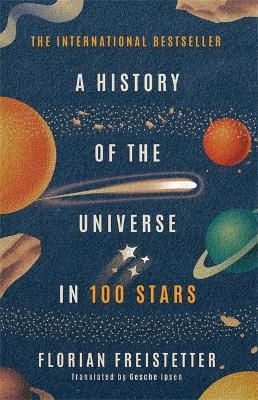
A History of the Universe in 100 Stars
Seiten
2022
Quercus Publishing (Verlag)
978-1-5294-1015-0 (ISBN)
Quercus Publishing (Verlag)
978-1-5294-1015-0 (ISBN)
Stars have always fascinated people. Astronomer Florian Freistetter tells the stories of the stars - past, present and future.
From the Big Bang to the Gaia Mission, this is a very personal history of the universe through the author's favourite 100 stars.
Astronomer Florian Freistetter has chosen 100 stars that have almost nothing in common. Some are bright and famous, some shine so feebly you need a huge telescope. There are big stars, small stars, nearby stars and faraway stars. Some died a while ago, others have not even yet come into being. Collectively they tell the story of the whole world, according to Freistetter. There is Algol, for example, the Demon Star, whose strange behaviour has long caused people sleepless nights. And Gamma Draconis, from which we know that the earth rotates around its own axis. There is also the star sequence 61 Cygni, which revealed the size of the cosmos to us.
Then there are certain stars used by astronomers to search for extra-terrestrial life, to explore interstellar space travel, or to explain why the dinosaurs became extinct.
In 100 short, fascinating and entertaining chapters, Freistetter not only reveals the past and future of the cosmos, but also the story of the people who have tried to understand the world in which we live.
From the Big Bang to the Gaia Mission, this is a very personal history of the universe through the author's favourite 100 stars.
Astronomer Florian Freistetter has chosen 100 stars that have almost nothing in common. Some are bright and famous, some shine so feebly you need a huge telescope. There are big stars, small stars, nearby stars and faraway stars. Some died a while ago, others have not even yet come into being. Collectively they tell the story of the whole world, according to Freistetter. There is Algol, for example, the Demon Star, whose strange behaviour has long caused people sleepless nights. And Gamma Draconis, from which we know that the earth rotates around its own axis. There is also the star sequence 61 Cygni, which revealed the size of the cosmos to us.
Then there are certain stars used by astronomers to search for extra-terrestrial life, to explore interstellar space travel, or to explain why the dinosaurs became extinct.
In 100 short, fascinating and entertaining chapters, Freistetter not only reveals the past and future of the cosmos, but also the story of the people who have tried to understand the world in which we live.
Florian Freistetter is an Austrian astronomer, blogger, author and podcaster. He did his doctorate at the Institute for Astronomy at the University of Vienna and then worked as an astronomer at the observatory of the University of Jena and the Astronomical Computing Institute in Heidelberg. He currently lives in Jena, blogs about science, writes books and is part of the science cabaret Science Busters.
| Erscheinungsdatum | 05.04.2022 |
|---|---|
| Übersetzer | Gesche Ipsen |
| Verlagsort | London |
| Sprache | englisch |
| Maße | 128 x 196 mm |
| Gewicht | 240 g |
| Themenwelt | Sachbuch/Ratgeber ► Natur / Technik ► Weltraum / Astronomie |
| Naturwissenschaften ► Physik / Astronomie ► Astronomie / Astrophysik | |
| ISBN-10 | 1-5294-1015-0 / 1529410150 |
| ISBN-13 | 978-1-5294-1015-0 / 9781529410150 |
| Zustand | Neuware |
| Haben Sie eine Frage zum Produkt? |
Mehr entdecken
aus dem Bereich
aus dem Bereich
Perspektiven auf die Menschheit
Buch | Hardcover (2024)
Klett-Cotta (Verlag)
25,00 €
auf der Suche nach neuen Planeten und außerirdischem Leben
Buch | Hardcover (2024)
Droemer (Verlag)
24,00 €


